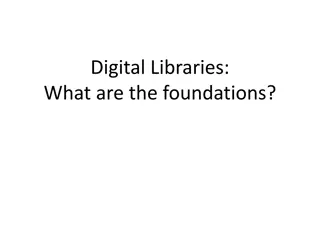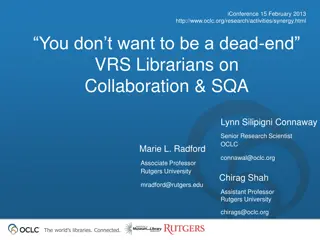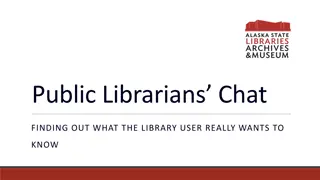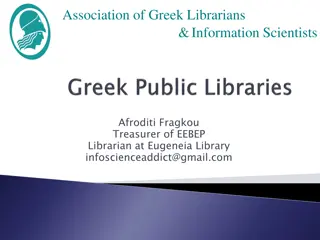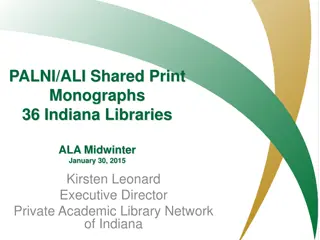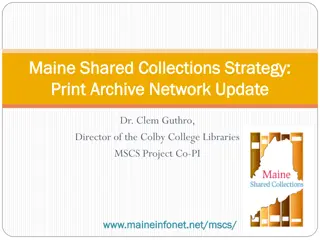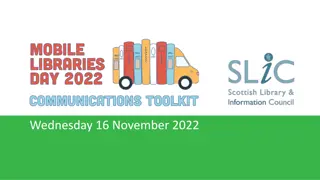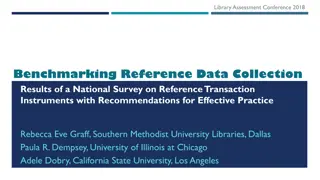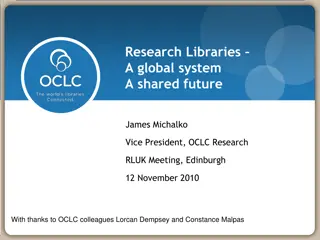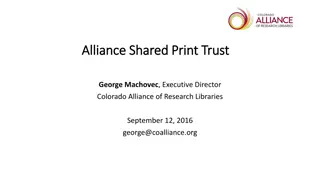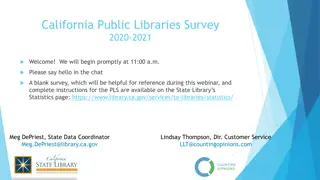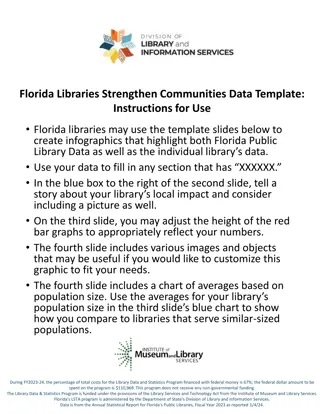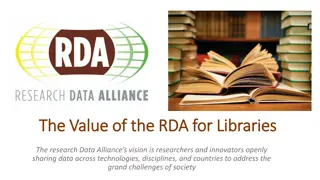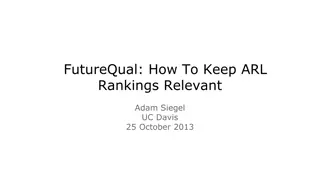Importance of Reference Services in Libraries
Reference services in libraries play a crucial role in connecting users with the information they need, promoting the use of library collections. This service assists users in various queries and requests, ranging from simple fact-finding to complex research. Reference functions include responsive services for in-person and remote assistance, as well as anticipatory services involving systematic preparation of bibliographical tools. The concept of reference service has evolved over time, with experts like Ranganathan emphasizing the personalized assistance provided to readers in finding relevant documents. Different definitions of reference service highlight its role in aiding users in their information needs and enhancing access to library resources.
Download Presentation

Please find below an Image/Link to download the presentation.
The content on the website is provided AS IS for your information and personal use only. It may not be sold, licensed, or shared on other websites without obtaining consent from the author. Download presentation by click this link. If you encounter any issues during the download, it is possible that the publisher has removed the file from their server.
E N D
Presentation Transcript
BLISc PAPER- BLIS/2/CT/07 Information Sources and Services Unit 3: REFERENCE Services NAVEEN CHAPARWAL GUEST FACULTY, DLISC, UCSSH, MLSU, UDAIPUR
A reference service is the ultimate goal of all library services. It is this service that connects the users with the documents and information, they need and promotes use of the collections built in a library. The different categories of users, their information needs, the world of documents and their intricacies, the types of enquiries and requests made in libraries, are some of the factors that necessitate reference service. Reference functions are of two kinds: Responsive and Anticipatory. The former includes services that deal with those who visit libraries in person, and others who choose to obtain services through telephone or seek assistance through letters or send telex/fax messages or even E-mail, now-a-days. The questions or enquiries may range from simple fact-finding ones to more complex ones involving searches through a wide range of reference materials and other documents for obtaining the required information. Anticipatory reference service would include systematic preparation and production of several types of bibliographical tools: Many aspects of their design are discussed below in some detail.
Samuel Green, the librarian of the Worcester Free Public Library in Massachusetts, introduced the concept of reference service when he suggested that the librarian should assist the user in the selection of books. (Genz, 1998). Since then, the concept of reference service has evolved a lot. The term reference service now denotes a wide range of activities undertaken by the library staff to promote and ensure use of collections and services offered by them. Reference service, is the process of helping readers to identify sources of information in response to a particular query, problem or assignment to be done. Following are some of the definitions of reference service given by the various experts. Ranganathan has defined reference service as a personal service to each reader in helping her/him to find the document, answering the particular query, pinpointedly, exhaustively and expeditiously. Ranganathan has also emphasised that the reference service aims at providing the right book to the right reader at the right time. He further said that the questions or queries which are answered by the library staff can be categorised as: Ready reference queries Short range queries Long range queries
W. Bishop has defined reference service as, the service rendered by a librarian in aid of some sort of study. It is an organised effort on the part of libraries in aid of the most expeditious and fruitful use of their books. (Genz, 1998) Margaret Hutchins has defined reference service as direct personal aid within a library, to persons in search of information for whatever purpose and also various activities specially aimed at making information as easily available as possible. William Katz opines that reference service is behind the scene activities of the reference library in the selection, acquisition and maintenance of the library stock and its careful and administration.
All the libraries, irrespective of their types-public, academic, or special libraries provide reference service only the extent or scale of the reference service rendered differs. The different types of libraries may provide one or more of the following services: Telling the readers of the availability of a particular document in the collection. Selection of books, online resources, websites, etc. Fact finding from print or electronic resources. Telling the students how to access e- resources or card catalogue or online catalogue. Literature search, preparation of bibliographies, etc. for researchers. Verification of references used by the researchers. Reference service is the service that intends to connect the users with the information sources they need. The service also aims to enhance the use of holdings of the library. The most important point to be stressed here is that the reference service seeks to fulfil the greater mission of the library, which is to maximise the use of resources and services, by helping the individual readers.
Types of reference service: The goals of Library s reference service are to connect library users with the best available library and information resources for their research needs, and to achieve the connection between the library and users in most effective manner. According to it s nature , reference service may be categorized as two different types, i. Ready reference service; ii. Long-range reference service. Ready Reference Service: Ready reference service is reference service finished in a very short time- in a moment if possible. The concepts of ready reference service is based on duration of time. Most ready reference questions are solved in a few minutes, while some take a longer time but seldom more than half-an hour. In case of ready reference service, the reference staff is able to answer the inquiry in a very short duration of of time, may be at immediately. Different reference books are used in ready reference service, such as Encyclopaedia, Dictionaries, Yearbooks, Directories, Biographical dictionaries, Geographical dictionaries, etc.
Long-range Reference Service: Long-range reference service in not capable to be rendered immediately. Few long range reference questions take less than half an hour, while some take a whole day and even weeks. In long range reference service, the search of information starts with ready reference services of information and is continued into ordinary books, reports, periodicals, etc. In case, information is not located in the library, then search may be continued into resources of other libraries even carried out to libraries in other parts of the world. METHODS OF ORIENTATION OFA FRESHMAN Library orientation is conducted in the beginning of the academic year to make the freshers familiar with the library holdings, services and facilities. preferred the term initiation of a freshman to orientation . library to the freshman. According to Krishnakumar(1991) Library orientation is to train the users in how to use the library . Dr. S.R.Ranganathan, Orientation is introducing the
Methods lecture seminar/tutorial/ demonstration guided tour film video tape tape/slide audio tape/illustration audio tape book, printed guide etc. (micro-media) practical exercises programmed instruction self-instructional material (tours, signs etc.) individual help.
Kind and Evaluation of Reference Sources Reference Sources are referred to as compilation, specifically designed to provide items of in-formation in a most convenient form. The main conventional categories are encyclopaedias, dictionaries, directories, yearbooks, bibliographies biographical and geographical information sources. The reference collection of any library should include the best and latest editions of the encyclopaedias, dictionaries and other reference books, bibliographical sources, indexes, catalogues and guides, standard histories and gazetteers, editions of the classic works of literature. Authoritative works on other subjects should be added as far as budget permits, especially those, which are more fitted for occasional consultation rather than for continuous reading. The reference books are many in number. No single library can afford to buy all the available reference sources. Also there is no available select list, which can indicate ideal reference collection for an ideal library. More complexity has arisen due to availability of reference books in other media other than the print media. But ultimately, the best reference collection is said to be the one, which is useful for both the reference librarian and the users. For convenience sake, peers have classified the reference sources into primary sources, secondary sources and tertiary sources based on the type of information sources included in them.
Primary Sources These are materials, which are original in nature. They usually take the form of a journal article, a monograph, a dissertation, a report or a patent or documents in archives. These mate-vials are also referred to as primary sources as they have not passed through any filtering mechanism like condensation, interpretation or evaluation and are the original work of the author. The primary sources are very large in number and can be usually accessed with the help of some secondary source like, a bibliography, an indexing service, or an abstracting service. Secondary Sources A secondary source is one that gives information about a primary source. The original information is selected, modified and rearranged in a suitable format for the purpose of easy location by the users, e.g., indexes, abstracts, bibliographies, encyclopaedias, yearbooks, gazetteers, who's who. An autobiography is a primary source whereas a biography written by other person is a secondary source. Tertiary Sources The tertiary sources consist of information that is a distillation and collection of primary and secondary sources. These include lists of all kinds of sources of reference works like the encyclopaedias, dictionaries, yearbooks, bibliography of 'bibliographies, almanacs, etc.
Reference sources are the backbone of a library. It helps the libraries and librarian in maintaining the question banks from which answer to queries of the users and material required by users are available. It may be added that the border line of demarcation between a reference book and others is not always sharp. The decisions as to whether or not to regard a given book as a reference book will sometime different from library to library. checklists for evaluation of reference sources are more or less same for all types of work. They can be applied to all sources with slight modification. The mnemonic form APPARATUS can be used as a check points for their appraisal. The APPARATUS indicates: The A-Authority P- Purpose, Price P- Physical format, Picture A-Arrangement R- Receney, Revision A-Accuracy T- Treatment U- Use S- Scope
Authority: The work should be authoritative. The authoritiveness of a reference book can usually be judge on the basis of qualification, experience and reputation of the sponsoring body (if any), publisher, distributor, author(s), Editor(s), Compiler(s).Purpose, Price: What is the purpose of the work as stated by the editor himself? Has this purpose been full field in the main work? What is the total cost of the work and whether the cost can be justified on the basis of its content? Physical Format, Picture: It refers to the physical make up of the book. All reference works should be a handy volume easy to withstand wear and tear. Format refers to binding quality of paper, typefaces, page make up, illustration, plates, diagrams, maps etc. Binding is of special consideration for bulky works likely to be used heavily. Type face should be clear and legible with suitable headings and subheading in bold types for the guidance of the readers. Arrangement: A reference sources demand easy and quick location of recorded entries. Goods arrangement adds to the value of a reference sources. The information must be systematically arranged. It is essential to have a detailed index which should provide for various kinds of approaches. The arrangement of the main text can be classified or chronological or geographic or alphabetical or some other. The kind of arrangement used should have a sound basis. Index to the main text is extremely important. The index should be detailed one providing reasonable number of approaches complemented by cross references. The index can be alphabetical or classified or some other. Receney, Revision: Information is always developing, some old becomes obsolete and some new are added. So in the evaluation process, the evaluator should keep it in mind to check whether the work is current and update or not. A continuous revision policy must be followed. Some works may issue supplements containing new information. What devices it uses to keep the bibliographies up to date. Though some reference sources may contain some retrospective information, every year it should be thoroughly revised and updated. The time lag is important for current sources.Accuracy: The work should be judged by the accuracy of the facts mentioned in the work. Treatment: It is to be ascertained whether the information is reliable and accurate or not, whether the treatment is biased or unbiased. It includes how through, reliable and complete is the information e.g. Facts, statistics, place, names, names of persons, names of organization, bibliography whichever is applicable. Treatment should also include questions like does it show any bias on controversial topics. Has the space allocated for a topic related to the degree of importance attached to a topic? Has the work written for scholars or layman, adults or children? How readable is the writing etc. Use: If the work will be purchased then who will be the user, who will benefit from the work. Does the library have such kind of user base or not? Scope: The kind of information included would depend upon the scope of the work. Some work may cover a particular country or the whole world or all subjects while others may be restricted to some specific or minute topic only. The date or period covered is an important criterion. Sometimes it may relate to a particular subject, organization also. The content page, preface, and introduction may give an idea of the information contained in the work. What are the limitations of the reference work with regard to subject, class of reader, up- to-dateness of material, what is the overall coverage? Does it follow a definite plan consistently? What is the extent of supervision provided by the editor(s).
Refrence Service in Internet Era: RSS, Blogs, Chat Referencing and Instant messaging RSS RSS is an acronym for Really Simple Syndication and Rich Site Summary. RSS is an XML-based (eXtensible Markup Language) format for content distribution. Webmasters create an RSS file containing headlines and descriptions of specific information. While the majority of RSS feeds currently contain news headlines or breaking information the long term uses of RSS are broad. RSS is a defined standard based on XML with the specific purpose of delivering updates to web- based content. Using this standard, webmasters provide headlines and fresh content in a succinct manner. Meanwhile, consumers use RSS readers and news aggregators to collect and monitor their favorite feeds in one centralized program or location. Content viewed in the RSS reader or news aggregator is place known as an RSS feed. RSS is becoming increasing popular. The reason is fairly simple. RSS is a free and easy way to promote a site and its content without the need to advertise or create complicated content sharing partnerships.
Application of RSS in Library Services RSS is a convenient way to keep the library users up-to-date with new content on the library website. Instead of having to click through the various sections of the library s site to see what s new, users can have that information pushed directly to their computer! RSS has been adopted by many news services (The New York Times, National Public Radio, The Wall Street Journal, BBC News, etc.), blogs, and other commercial sites (WebMD, ESPN, Orbitz, People, Salon, Yahoo!, eBay, etc.). Even the government has embraced RSS. RSS can be applied to some of the following Library & Information Services: Selective Dissemination of Information CurrentAwareness Service Bibliographic Service Bulletin Board Service RSS is a technology that has the potential of overcoming many of the Library and Information Marketing challenges we are facing today and becoming a preferred tool to get 100% of our content delivered to the users, as well as a tool to help us making the library website top searchable site.
Library blog Blog is short for web log-an online journal where information including text, audio, video, images is posted on a regular basis and appears in chronological order. It is developing very rapidly. It is quick and popular way to share thoughts with the world. This is one of the tools of web 2.0 services. It falls under read / write web component category. Blog is a powerful two way based tool. A blog is a website on which library patrons can post their views, ideas, thoughts, comments and suggestions. Any matter entered on a blog is known as blog post. These posts are made in journal style and are displayed in chronological order. It allows searching of entries listed in specific categories. It also links to other sites of interest and provides places for comments and monthly archive of pervious entries. Any library patron can publish a blog post easily and cheaply through a web interface and also any user can post a comment on blog post. Blog in academic library It can be used for the collection development because users can request the required resources. - Library can use blog as a marketing tool for advertising the library and its resources. - It can be used as platform for discussion. - It can be used as forum where patrons can post their views, queries, concerns, ideas, comments, suggestions etc. - It can be used as platform where users can comment on library services and activities. - - - - -
Digital reference service is an Internet-based question-and-answer service that connects the user with experts in a variety of subject fields and possessing specialized subject or skill experience. In addition to this, experts also provide users with referral to other online and printed information sources. Digital reference service can be broadly categorized into two groups: E-Mail Reference Service: In this service, the user sends e-mail to the library with a reference question, seeking whatever information he feels necessary. The library sends reply by e-mail, fax, phone or letter as it finds convenient. When a query is sent by a user, the controller of the query in the library first receives it and examines and then routes it to the appropriate people who can handle the query. Technical questions are forwarded to technical staff, circulation-related questions to the circulation staff, reference question to the reference librarian, and so on. Examples of prominent e-mail reference services are: Askme,AllExperts, Inforocket, Xrefer, Reference Desk, Infoplease, etc. Real Time Digital Reference Service: In real time digital reference service, the exchange of information is live (it takes place in real time) between the user and the reference librarian. Examples are: Ask A Question, Ask Now!, Ask The Librarian, Real Time Reference, Virtual Reference Desk, etc.
Instant Messaging Service According to International Engineering consortium, Instant Messaging (IM) is an internet protocol based application that provides convenient communication between people using a variety of different device types. Instant messaging is a type of communication service over the internet which enables individuals to exchange text messages and track availability of a list of users in real time. There are many free public domain instant messaging services. But most popular are AOL Instant Messenger (AIM), ICQ, MSN Messenger and Yahoo! Instant Messenger (YIM) Instant Messaging is also known by chat reference or virtual reference. It has become important point for users to get information and reference help. It is referred as unique method of communication between library staff and users. Instant messaging provides cost beneficial means of communication in real time and also supports effective communication between employees. It provides informal means of communication which helps library staff to create good relationship with users.
References http://egyankosh.ac.in/bitstream/123456789/34970/1/Unit-4.pdf http://www.lisbdnet.com/reference-service-library/ http://www.iiserpune.ac.in/~library/life2017/program/16/11-jesudoss- manalan.pdf http://egyankosh.ac.in/bitstream/123456789/35344/5/BLI-222-B4.pdf Ranganathan, S. R. Five Laws of Library Science. Madras: Madras Library Association, 1931. Web.< http://dlist.sir.arizona.edu/1220/>. http://egyankosh.ac.in/bitstream/123456789/33141/1/Unit-1.pdf Grogan, Denis J. (1992). Practical Reference Work. 2nd ed. London: Library Association Publishing. Grogan, Denis, J. (1982). Science and Technology: An Introduction to the Literature. 4th ed. London: Clive Bingley. Higgins, Gavin (ed). (1983). Printed Reference Material. 2nd ed. London: Library Association. Katz, William A. (1992). Introduction to Reference Work. Vol.1: Basic Information Sources. 6th ed. New York: McGraw-Hill. Ranganathan, S.R. (1961). Reference Service. 2nd ed. reprint. Bangalore: Sarada Ranganathan Endowment for Library Science.
http://www.netugc.com/evaluation-of-reference-sources https://inflibnet.ac.in/caliber2009/CaliberPDF/42.pdf https://shodhganga.inflibnet.ac.in/bitstream/10603/203389/10/10_chapte r%202.pdf http://egyankosh.ac.in/bitstream/123456789/11258/1/Unit-11.pdf


